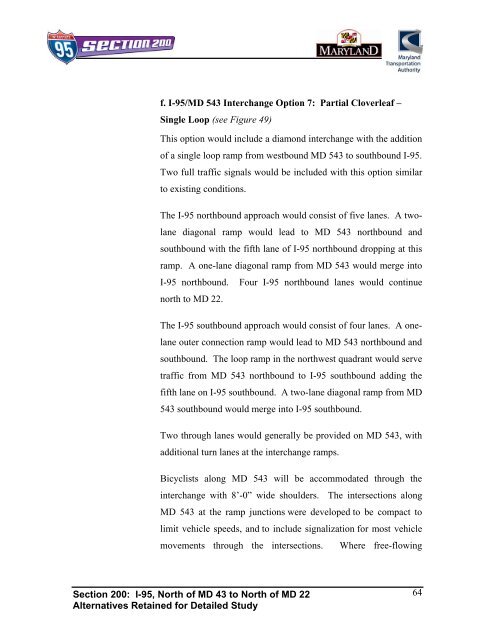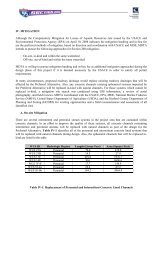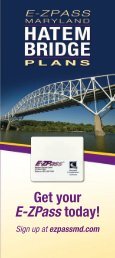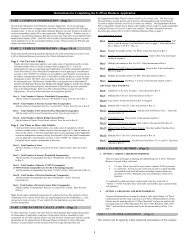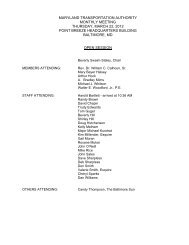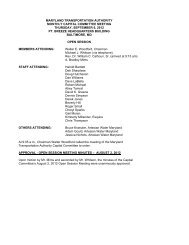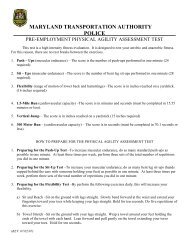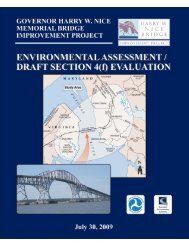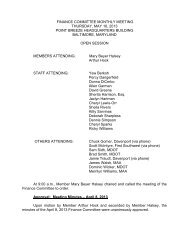f. I-95/MD 543 Interchange Option 7: Partial Cloverleaf â Single ...
f. I-95/MD 543 Interchange Option 7: Partial Cloverleaf â Single ...
f. I-95/MD 543 Interchange Option 7: Partial Cloverleaf â Single ...
You also want an ePaper? Increase the reach of your titles
YUMPU automatically turns print PDFs into web optimized ePapers that Google loves.
movements were unavoidable, designs were based on nearminimum turning conditions in an effort to limit vehicle speeds.Section 200: I-<strong>95</strong>, North of <strong>MD</strong> 43 to North of <strong>MD</strong> 22Alternatives Retained for Detailed Study65
g. I-<strong>95</strong>/<strong>MD</strong> 22 <strong>Interchange</strong> <strong>Option</strong> 1: <strong>Partial</strong> <strong>Cloverleaf</strong> –Double Loop with Modifications to CD roads (see Figure 50)This option would maintain the existing partial cloverleafconfiguration with no modifications. The existing interchangecontains loops in the northwest and southeast quadrants. One fulltraffic signal along <strong>MD</strong> 22 provides access for the I-<strong>95</strong> northboundoff-ramp. One full traffic signal along <strong>MD</strong> 22 provides access forthe I-<strong>95</strong> southbound off-ramp. I-<strong>95</strong> through the interchange wouldconsist of four GPLs in each direction.The existing I-<strong>95</strong> northbound approach adds a one-lanecollector/distributor roadway. A one-lane ramp then leads to <strong>MD</strong>22. The existing I-<strong>95</strong> southbound approach adds a one- lanecollector/distributor roadway. A one-lane ramp then leads to <strong>MD</strong>22.There are no modifications to <strong>MD</strong> 22 through the interchange.Two through lanes are generally provided, with additional turnlanes at the interchange ramps. Bicyclists are accommodatedthrough the interchange with 8’-0” wide shoulders.Section 200: I-<strong>95</strong>, North of <strong>MD</strong> 43 to North of <strong>MD</strong> 22Alternatives Retained for Detailed Study67
3. Express Toll Lanes Alternatea. MainlineThis alternate would include adding ETLs to the existing GPLs toaccommodate the projected traffic demand. This alternate would extendthe typical section of Section 100 from just north of the <strong>MD</strong> 43interchange to north of <strong>MD</strong> 24 interchange. This typical section consistsof four GPLs and two ETLs in each direction. From north of <strong>MD</strong> 24 tonorth of <strong>MD</strong> <strong>543</strong>, three existing GPLs would be retained, providing threeGPLs and two ETLs in each direction. The ETLs would terminate at <strong>MD</strong><strong>543</strong> providing four GPLs to the project limits north of <strong>MD</strong> 22.Improvements would be proposed at the <strong>MD</strong> 152, <strong>MD</strong> 24, and <strong>MD</strong> <strong>543</strong>interchanges. At the northern limit of Section 200, the four GPLs willmerge to tie into the existing three GPLs in each direction.Figure 51 – Recommended Express Toll Lane AlternateSection 200: I-<strong>95</strong>, North of <strong>MD</strong> 43 to North of <strong>MD</strong> 22Alternatives Retained for Detailed Study69
. I-<strong>95</strong>/<strong>MD</strong> 152 <strong>Interchange</strong> <strong>Option</strong> 1A: Diamond with ETLMedian Access Ramps (see Figure 52)This option would consist of a diamond interchange. Theinterchange includes median ETL ramp access to <strong>MD</strong> 152. Twofull traffic signals would serve I-<strong>95</strong> GPL traffic and one full trafficsignal would serve I-<strong>95</strong> ETL traffic. This option incorporates culde-sacsto eliminate direct access from Old Mountain Road into theinterchange ramp area. The Old Mountain Road bridge over I-<strong>95</strong>would be removed and would not be replaced.The I-<strong>95</strong> northbound approach would consist of four GPLs and twoETLs through the interchange. A one-lane diagonal GPL rampwould lead to <strong>MD</strong> 152 northbound and southbound. A one-lanediagonal ramp from <strong>MD</strong> 152 would merge into I-<strong>95</strong> GPLnorthbound. One-lane, left-side median ETL ramp would connectI-<strong>95</strong> northbound ETLs to <strong>MD</strong> 152 northbound and southbound. Aone-lane, left-side median ETL ramp would lead to the I-<strong>95</strong>northbound ETLs.The I-<strong>95</strong> southbound approach would consist of four GPLs andtwo ETLs through the interchange. A one-lane diagonal GPLramp would lead to <strong>MD</strong> 152 northbound and southbound. A twolanediagonal ramp from <strong>MD</strong> 152 would merge into I-<strong>95</strong> GPLsouthbound. One-lane, left-side median ETL ramps would connectI-<strong>95</strong> southbound ETLs to <strong>MD</strong> 152 northbound and southbound. Aone-lane, left-side median ETL ramp would lead to the I-<strong>95</strong>southbound ETLs.Two through lanes would generally be provided on <strong>MD</strong> 152, withadditional turn lanes at the interchange ramps.Section 200: I-<strong>95</strong>, North of <strong>MD</strong> 43 to North of <strong>MD</strong> 22Alternatives Retained for Detailed Study70
Bicyclists along <strong>MD</strong> 152 will be accommodated through theinterchange with 8’-0” wide shoulders. The intersections along<strong>MD</strong> 152 at the ramp junctions were developed to be compact tolimit vehicle speeds, and to include signalization for most vehiclemovements through the intersections. Where free-flowingmovements were unavoidable, designs were based on nearminimum turning conditions in an effort to limit vehicle speeds.Section 200: I-<strong>95</strong>, North of <strong>MD</strong> 43 to North of <strong>MD</strong> 22Alternatives Retained for Detailed Study71
c. I-<strong>95</strong>/<strong>MD</strong> 152 <strong>Interchange</strong> <strong>Option</strong> 4A: <strong>Partial</strong> <strong>Cloverleaf</strong> –<strong>Single</strong> Loop with ETL Median Access Ramps (see Figure 53)This option would include a diamond interchange, with a singleloop ramp from northbound I-<strong>95</strong> to northbound <strong>MD</strong> 152. Theinterchange includes median ETL ramp access to <strong>MD</strong> 152. Twofull traffic signals would serve I-<strong>95</strong> GPL traffic and one full trafficsignal would serve I-<strong>95</strong> ETL traffic. This option incorporates culde-sacsto eliminate direct access from Old Mountain Road into theinterchange ramp area. The Old Mountain Road bridge over I-<strong>95</strong>would be removed and would not be replaced.The I-<strong>95</strong> northbound approach would consist of four GPLs and twoETLs through the interchange. A one-lane diagonal GPL rampwould lead to <strong>MD</strong> 152 southbound, followed by a one-lane loopGPL ramp to <strong>MD</strong> 152 northbound. A one-lane, left-side medianETL ramp would lead to <strong>MD</strong> 152. A one-lane, left-side medianETL ramp would lead to the I-<strong>95</strong> northbound ETLs.The I-<strong>95</strong> southbound approach would consist of four GPLs andtwo ETLs through the interchange. A one-lane diagonal GPLramp would lead to <strong>MD</strong> 152 northbound and southbound. A twolanediagonal ramp from <strong>MD</strong> 152 would merge into I-<strong>95</strong> GPLsouthbound. One-lane, left-side median ETL ramps would connectI-<strong>95</strong> southbound ETLs to <strong>MD</strong> 152 northbound and southbound. Aone-lane, left-side median ETL ramp would lead to the I-<strong>95</strong>southbound ETLs.Two through lanes would generally be provided on <strong>MD</strong> 152, withadditional turn lanes at the interchange ramps.Section 200: I-<strong>95</strong>, North of <strong>MD</strong> 43 to North of <strong>MD</strong> 22Alternatives Retained for Detailed Study73
Bicyclists along <strong>MD</strong> 152 will be accommodated through theinterchange with 8’-0” wide shoulders. The intersections along<strong>MD</strong> 152 at the ramp junctions were developed to be compact tolimit vehicle speeds, and to include signalization for most vehiclemovements through the intersections. Where free-flowingmovements were unavoidable, designs were based on nearminimum turning conditions in an effort to limit vehicle speeds.Section 200: I-<strong>95</strong>, North of <strong>MD</strong> 43 to North of <strong>MD</strong> 22Alternatives Retained for Detailed Study74


